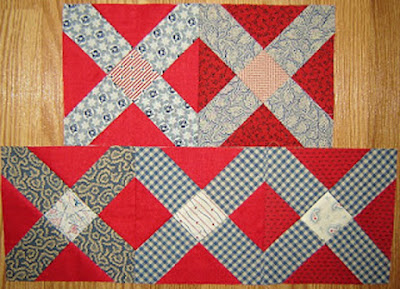Yankee Diary Block 4: Right Makes Might
by Danielle Bohannon.
A 15" finished flag.
From Carrie's diary, February 28, 1860.
"Grandfather asked me to read Abraham Lincoln's
speech aloud which he delivered in Cooper Institute, New York, last evening,
under the auspices of the Republican Club. He was escorted to the platform
by David Dudley Field....The New York
Times called him 'a noted political exhorter and Prairie orator.' It was a
thrilling talk and must have stirred men's souls."
Mother's cousin Dudley Field II,
prominent New York lawyer,
hosted the Cooper
Institute event.
Carrie and Grandfather Beals were undoubtedly proud that
Grandmother's nephew David Dudley Field hosted the Presidential candidate in Manhattan. Abigail Field Beals's illustrious nephews also
included Stephen Field who became an
associate justice of the U.S. Supreme Court and Cyrus Field, famous for laying
the Atlantic telegraph cable.
Nominee Abraham
Lincoln in the national news magazine
Harper's Weekly.
The Presidential election of 1860 defined American discord.
The Democratic party split, nominating two candidates to represent Northern and
Southern interests. A new party, the Constitutional Unionists, nominated their
own candidate and another new party, the Republicans, nominated Abraham Lincoln
whose eloquent speech at the Cooper Institute brought him national attention.
The Cooper
Institute Building still stands
at Cooper Square on St Marks Place in the East Village.
Here Lincoln made a speech ending with:
"Let us have faith that right makes
might."
Carrie and Grandfather Beals were probably pleased that
Lincoln was nominated and elected but Carrie at 18 years old didn't have much
to say about Lincoln's campaign through 1860.
Lincoln political meeting in neighboring Geneva
In November while votes were
counted and Southern states threatened to secede if Lincoln won she worked on a
patchwork project.
A quilt of silk
hexagons backed with papers dated 1864
November 21, 1860
"I am trying
to make a sofa pillow out of little pieces of silk. Aunt Ann taught me how. You
have to cut pieces of paper into octagonal shape and cover them with silk and
then sew them together, over and over. They are beautiful, with bright colors
when they are done. There was a hop at the hotel last night and some of the
girls went and had an elegant time."
I bet Carrie meant hexagonal shape but no one ever
gets that word right---be it 1860 or 2017. Hexagon: 6 sides. Octagon: 8 sides.
In 1858 a drygoods store in Canandaigua promised Silks!
Silks!
Aunt Ann Beals Field (1805 - 1896),
Mother's sister and another cousin to the famous Field brothers
The Brothers Field
by Matthew Brady.
The Field family
was a 19th-century New York powerhouse.
Flag from a quilt dated 1853 in the collection of the Smithsonian
Institution, made in South Reading, Massachusetts.
When Lincoln became President the following year "the storm in the air" finally demanded Carrie's attention.
"I read the inaugural address aloud to Grandfather this evening. [Lincoln] dwelt with such pathos upon the duty that all, both North and South, owe to the Union, it does not seem as though there could be war!"
Block 4 by Barbara Brackman
My 15" x 15" (finished size) flag is drawn from an applique sampler that featured a
flag in each corner.
Sampler by Dorothea Klein Lemley,
Sheboygan, Wisconsin, blocks 1861-1865,
possibly
assembled later,
from my book Civil
War Women.
I love Dorothea's free-form appliqued stripes. All my
friends advised me I could have pieced the stripes faster and more accurately,
but that's the point!
Those appliqued stripes are charming. My
love for charm, however, did not extend to appliquéing 13 stars in the blue
field like Dorothea did, so I stitched one large star to a polka dot ground.
See more ideas for starry fields in last Saturday's post.
http://civilwarquilts.blogspot.com/2017/04/34-stars-in-flag.html
Becky Brown's flag with appliqued stripes is nicely symmetrical.
The measurements are different from mine.
You need a pieced variable star finishing to 6" and some wiggly applique stripes.
See below.
Cutting a 15" Flag
For the flag cut a background square 15-1/2" x
15-1/2"
A - See the template below for the star that finishes to 4-1/4"
inches. Add seams. You can piece or applique it.
B - For applique: Cut a square 5-1/2" x 5-1/2" Applique the
star to the field. Turn the edges under and applique the field after you've
sewn down the stripes.
C - Cut 2 red strips 1-3/4" x 10-3/4". (Note: I cut the top stripe a little wider.)
Turn the edges under and applique.
D - Cut 3 red strips 1-3/4" x 15-1/2" . Turn the edges under and applique.
To Print:
- Create a word file or a new empty JPG file.
- Click on the image above.
- Right click on it and save it to your file.
- Print that file. Check to be sure the box line is 5".
- Add seam allowances when you cut the fabric.
Becky's design wall with the top half of the finished quilt,
Blocks 1 to 4.
Denniele's
Trying to keep all those Bealses and Fields straight is a puzzle made easier to solve by Nancy T. Hayden's book The Complete Guide to Village Life in America. Nancy is apparently as crazy about Carrie's world as I am. Her book contains a walking tour of Carrie's neighborhood, portraits & short biographies of everybody mentioned in the diary.
Buy it at the Ontario County Museum:
Instructions for Becky's Flag
The 6" Finished Star
A - Cut 4 squares 2".
B - Cut 1 square 4-1/4". Cut into 4 triangles with 2 diagonal cuts.
You need 4 triangles.
C - Cut 4 squares 2-3/8", Cut each into 2 triangles with a diagonal cut.
You need 8 triangles.
D - Cut 1 square 3-1/2".
The Stripe
Above is a JPG of the top half of the flag which
should print out 6" x 9". Use it for your appliqued
stripe and add seams.


















































